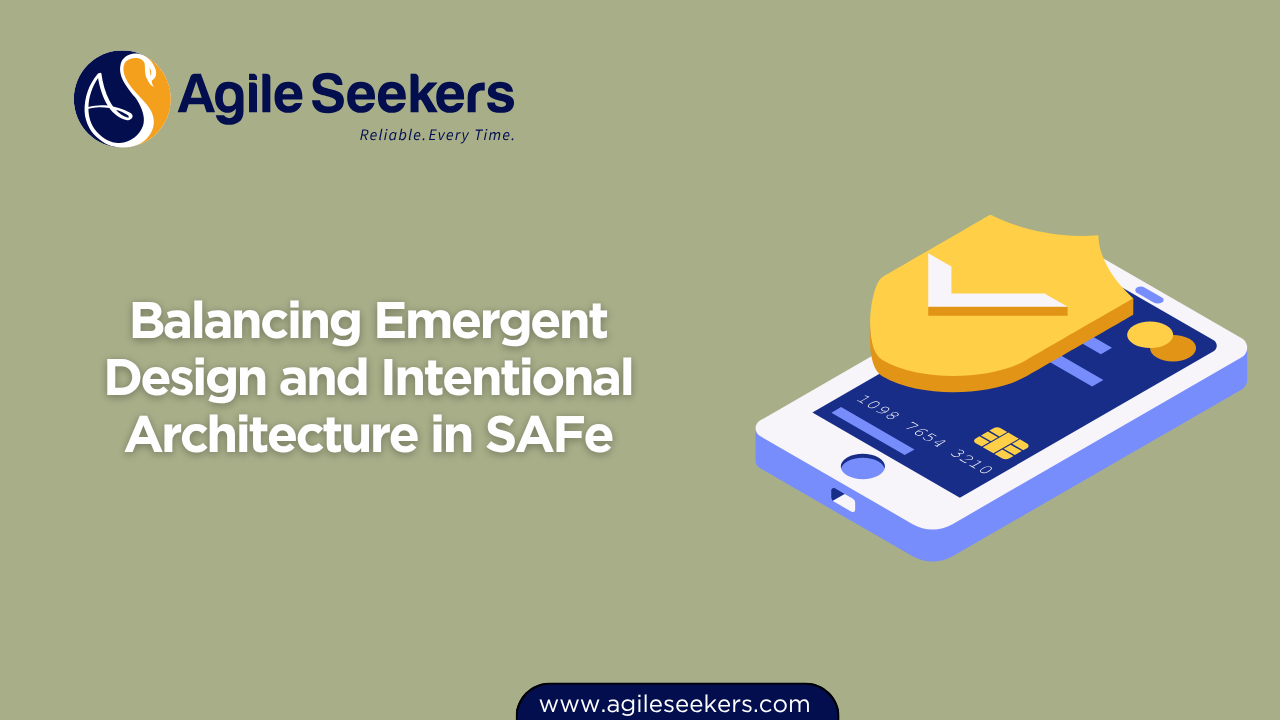Balancing Emergent Design and Intentional Architecture in SAFe

In large enterprises, architecture plays a critical role in enabling agility at scale. Yet, rigid architecture stifles innovation, while too much flexibility without direction leads to chaos. The Scaled Agile Framework (SAFe) solves this by encouraging a balance between intentional architecture—a planned set of architectural strategies—and emergent design, which allows teams to innovate and adapt as they build solutions.
This blog explores how SAFe brings structure and adaptability together to support fast value delivery, system integrity, and long-term sustainability.
What Is Intentional Architecture in SAFe?
Intentional architecture refers to the deliberately planned aspects of the system that provide guidance for building scalable and reliable solutions. This includes architectural runways, platform decisions, security standards, data governance, and cross-cutting concerns like performance or observability.
SAFe defines intentional architecture as "a set of purposeful, planned architectural strategies and initiatives that align with business goals and enable incremental value delivery."
It doesn’t mean locking in every decision up front—it means providing enough structure so teams can move fast without compromising quality.
Intentional architecture supports:
-
Alignment with business strategy
-
Cross-team consistency
-
Enabling reuse and reducing redundancy
-
Simplifying system evolution
Learn more in the SAFe architectural guidance.
What Is Emergent Design in SAFe?
Emergent design refers to architecture that evolves as teams build features and learn from feedback. This ensures that solutions reflect real-world needs and can adapt to new information.
Emergent design is not a lack of design—it’s a disciplined process driven by principles like test-first development, refactoring, continuous integration, and collective code ownership.
SAFe promotes emergent design through:
-
Team-level autonomy
-
Decentralized decision-making
-
Frequent system demos and iteration reviews
-
Technical agility and DevOps practices
Why SAFe Encourages Both
SAFe recognizes that neither approach alone is enough. Intentional architecture without emergent design becomes rigid and outdated. Emergent design without structure can lead to fragmented solutions and scaling problems.
By combining both, SAFe enables:
-
A stable foundation (intentional architecture)
-
Continuous learning and responsiveness (emergent design)
This balance is key to scaling agility without sacrificing long-term system health.
Roles That Support Architectural Balance
Several SAFe roles actively contribute to balancing intentional and emergent architecture:
-
System Architects/Engineers lead the creation and evolution of intentional architecture, shaping the architectural runway.
-
Agile Teams contribute to emergent design by building and adapting technical solutions within the defined architectural guardrails.
-
Product Managers and Product Owners prioritize architectural enablers to ensure technology evolves with business needs. Learn more about the SAFe Product Owner/Product Manager (POPM) certification.
-
Release Train Engineers (RTEs) facilitate coordination across Agile Release Trains, ensuring architecture aligns with planning and delivery. The SAFe Release Train Engineer certification equips professionals to guide these efforts.
-
Scrum Masters and Advanced Scrum Masters help teams understand the value of both architecture and adaptability. This is explored further in SAFe Scrum Master Certification and Advanced Scrum Master Certification.
Mechanisms That Promote Balance in SAFe
1. Architectural Runway
The architectural runway includes existing code, components, and infrastructure that support new features without excessive redesign. It is continuously extended to support near-term goals while maintaining agility. For more insights, refer to the Leading SAFe Agilist certification, which covers architectural strategy in PI planning and Lean Portfolio Management.
2. Enabler Work
Enablers are backlog items that support exploration, infrastructure, compliance, or architecture. Teams and architects collaborate to identify and prioritize these items, making them visible and actionable.
3. Participatory Planning
During PI Planning, System Architects collaborate with teams to outline upcoming architectural needs. They share architectural vision and get feedback on feasibility and trade-offs. This mutual alignment is a cornerstone of SAFe.
4. Communities of Practice (CoPs)
Architects, developers, and DevOps engineers often form CoPs to share patterns, validate approaches, and evolve architectural principles collaboratively. This fosters shared ownership and innovation.
5. Guardrails and Decentralized Decision-Making
SAFe promotes decentralized decision-making within defined boundaries. Guardrails help teams innovate safely without breaking critical dependencies.
Common Challenges and How to Overcome Them
| Challenge | Mitigation Strategy |
|---|---|
| Over-engineering up front | Start with minimum architectural runway and evolve incrementally |
| Teams ignoring architectural guidance | Promote continuous collaboration and involve teams in architectural decisions |
| Architecture slowing down delivery | Use Enablers to fund and plan architecture work within each PI |
| Lack of visibility into system health | Invest in DevOps, observability, and system-level metrics |
Real-World Example: Digital Banking Platform
Consider a bank building a digital customer platform. The initial architecture includes APIs, identity management, and data encryption (intentional). Teams then develop new features—like loan calculators or real-time chat—based on user feedback (emergent). The architecture evolves to support microservices, containerization, and AI fraud detection as business needs grow.
This evolution is only possible because the system had a clear architectural foundation and room for learning-driven growth.
Benefits of Balancing Emergent and Intentional Architecture
-
Faster time to market with reduced technical debt
-
Better alignment between business and technical goals
-
Enhanced team autonomy and innovation
-
Resilience to changing requirements
-
Improved system scalability and maintainability
By managing both types of architecture, organizations stay adaptable without sacrificing long-term goals.
Final Thoughts
Balancing intentional architecture with emergent design isn’t a trade-off—it’s a synergy. SAFe provides the mindset, roles, and mechanisms to achieve this balance effectively. Teams build what’s needed now, while architects guide what’s needed next.
This balance enables enterprises to deliver value quickly, scale responsibly, and evolve systems that meet real user needs without becoming fragile or outdated.
To dive deeper into how SAFe enables this architectural agility, explore the guidance on Agile Architecture in SAFe.
Also read - Architectural Runway: Building Future Capabilities Without Slowing Down Delivery
Also see - Designing for DevOps and Release on Demand in SAFe




















